Persistence of Summer Sea Surface Temperature Anomalies in the Midlatitude North Pacific and Its Interdecadal Variability
Xia ZHAO,Guang YANG,and Jing WANG
1Key Laboratory of Ocean Circulation and Waves,Institute of Oceanology,Chinese Academy of Sciences and Qingdao National Laboratory for Marine Science and Technology,Qingdao 266071,China
2Center for Ocean and Climate Research,First Institute of Oceanography,State Oceanic Administration,Qingdao 266061,China
3Laboratory for Regional Oceanography and Numerical Modeling,Qingdao National Laboratory for Marine Science and Technology,Qingdao 266071,China
1.Introduction
Sea surface temperature anomalies(SSTAs)have remarkable persistence due to the large thermal capacity of the ocean.Persistence of the ocean could store atmospheric signals due to the air–sea interactions,which would in turn influence atmospheric circulation and weather changes.Moreover,interannual and interdecadal variability are closely related to the persistence of SSTAs.Due to the important contribution of the ocean to the climate system,it is necessary to investigate the persistence of large-scale SSTAs.
The persistence of SSTAs shows a strong seasonal dependence.Previous studies on large-scale air–sea interaction in the midlatitude North Pacific have focused on the cold season because of the strong persistence of SSTAs and their strong coupling with atmospheric circulation.Wintertime SSTAs at midlatitudes could recur during the next winter but not during the intervening summer(e.g.,Namias and Born,1970,1974;Alexander and Deser,1995;Alexander et al.,1999;Hanawa and Sugimoto,2004).This winter-to-winter recurrence of SSTA sresults from the seasonal changes in the depth of the oceanic mixed layer.The thermal anomalies that are generated in the deep winter mixed layer are shielded by a shallow layer in the summer,and these anomalies are partially re-entrained into the surface layer when the mixed layer deepens again during the subsequent cold season.This process is called the reemergence mechanism.In addition,atmospheric forcing,as well as other ocean dynamics,is also important for the persistence of winter SSTAs in the North Pacific(e.g.,Sugimoto and Hanawa,2005;Qiu,2000;Xie et al.,2000;Zhao and Li,2010,2012a,2012b;Zhao et al.,2012).Our previous studies(Zhao and Li,2010,2012a,2012b)found that atmospheric circulation anomalies also show winter-to-winter recurrence in the central North Pacific,which may be one of the causes of the winter-to-winter recurrence of SSTAs in this region.If anomalous atmospheric forcing were to occur repeatedly over several consecutive winters,and not in the summer,this would tend to result in the recurrence of SSTAs in the winter.
The persistence of summer SSTA sis not clear.Ontheone hand,the results of Namias and Born(1970)indicated that the thermal anomalies that develop in the shallow summertime mixed layer are obliterated by vertical mixing during the late autumn or early winter storms,which leads to the rapid decay of summer SSTAs(e.g.,Deser et al.,2003).Moreover,the atmospheric circulation anomalies over the mid latitude North Pacific are weak during the summertime(e.g.,Wallace et al.,1993),so the air–sea interactions are unlikely to be as important during the summer.On the other hand,the mixed layer in the midlatitude North Pacific is much shallower in the summer than in the winter(e.g.,Monterey and Levitus,1997;Zhao and Li,2010,2012a).As such,even small atmospheric anomalies at the air–sea interface can induce large SSTAs.Moreover,positive cloud feedback makes an important contribution to the SSTAs in the North Pacific in summer(e.g.,Zhang et al.,1998;Wu and Kinter,2010).Therefore,summertime SSTAs in the North Pacific could last into the following autumn and winter seasons(Davis,1978;Zhang et al.,1998).This contradiction indicates a need to investigate the persistence of summer SSTAs in the midlatitude North Pacific.
Zhang et al.(1998)indicated that the apparent disagreement between the length of persistence of summertime SSTAs in the North Pacific,which was documented in their paper and estimated by Namias and Born(1970),may be partly due to the distinction between the autocorrelation of patterns of SSTAs[as inferred from empirical orthogonal function(EOF)analysis]versus the autocorrelation of SSTAs at fixed grid points.Therefore,due to the unclear issues about the persistence of summer SSTAs in the North Pacific,the characteristics of the spatial distribution of the summer SSTAs persistence in this region can be further investigated.In this study,we calculate the persistence time(in months)of summer SSTAs at each grid point(Fig.1).The persistence of summer SSTAs shows obvious geographical differences.The SSTAs have long persistence times(approximately 8–14 months)over the Kuroshio Extension(KE)region and the region north of 50°N,while short persistence times of less than 6 months are observed in other regions.Because there is a larger sea surface temperature(SST)gradient in the western and central basin of the midlatitude North Pacific(e.g.,Wu and Kinter,2010),it is interesting to further investigate what physical processes contribute to the long persistence of summer SSTAs in the KE region.
Numerous studies have presented the interdecadal variations in climate that occur over the North Pacific(e.g.,Trenberth and Hurrell,1994,Mantua et al.,1997,Zhang et al.,1997,Miller and Schneider,2000;Mantua and Hare,2002;Xiao and Li,2007;Ding and Li,2009;Chen et al.,2016;Newman et al.,2016;Achuthavarier et al.,2017).The interdecadal variability should be reflected in the persistence of SSTAs.The interdecadal variability of the persistence of summer SSTAs in the North Pacific is worthy of study because the air–sea interactions in the North Pacific exert a strong influence on the inter annual and inter decadal climate variations(e.g.,Davis,1978;Lau et al.,2002;Nonaka and Xie,2003;Liu and Wu,2004;Frankignoul and Senn′echael,2007).
This paper is structured as follows:The data and methods used in this study are described in section 2.Section 3 presents the spatial distribution of the persistence of summer SSTAs in the North Pacific.Sections 4 and 5 investigate the possible causes of the long persistence time of the summer SSTAs around the KE region.Section 6 presents the interdecadal variability of the persistence of summer SSTAs.And finally,we summarize and discuss our results in section 7.
2.Data and methods
The data used in this study include the SST from ERSST.v5(Huang et al.,2017),available at http://www.esrl.noaa.gov/psd/.Theclimatologicalmonthlymeanmixedlayer depth(MLD)is from the World Ocean Atlas 1994(Monterey and Levitus,1997),and the atmospheric data are from the NCEP–NCAR reanalysis dataset(Kalnay et al.,1996).The convection for heat flux is positive in the downward direction.The annual cycle of each variable is removed by subtracting the mean monthly value at each grid point.Moreover,since the tropical Pacific ENSO is known to exert a significant impact on the atmosphere and ocean in the North Pacific(Alexander et al.,2002),we remove the in fluence of the tropical Pacific on each variable at each grid point using a regression against the Ni?no3.4 SSTAs.

Fig.1.Spatial distribution of the persistence time(in months)of summer(July)SSTAs in the North Pacific.The persistence time is the time when the lag correlation of the summer SSTA at each grid drops to a non-significant level(95%).The frame indicates the region with long persistence(30°–45°N,150°E–170°W).
Previous studies on the persistence of SSTAs during summertime have concentrated on the SSTAs in a selected area or on the leading modes of the SSTAs obtained from an EOF.Zhang et al.(1998)showed that the leading mode of the SSTAs in the North Pacific is more persistent from one summer to the next than from one winter to the next.However,Namias and Born(1970)analyzed the autocorrelations of the SSTAs averaged over several spatial grid points and showed that the summer SSTAs were reduced within two months.Therefore,it is necessary to objectively obtain the spatial distribution of persistence of the SSTAs in the North Pacific during the summertime.In this paper,the persistence of summer SSTAs is based on a calculation at each grid point,which removes the dependence on specific spatial modes or area selection.We define the persistence of SSTAs based on the lag correlation coefficients and the duration of these coefficients above the 95%confidence level for the lag times.
3.Spatial distribution of the persistence of summer SSTAs
Figure 1 shows the spatial distribution of the persistence time(in months)of the summer SSTAs in the North Pacific,which exhibits obvious geographical differences.The result indicates that summer SSTAs have long persistence times(approximately 8–14 months)over the KE region and the region north of 50°N,while they have short persistence times that are shorter than 6 months in other regions.To show the behavior of the lag correlation coefficient,we de fine the region(30°–45°N,150°E–170°W)with long persistence times as the LP region.Figure 2 shows the lag correlation of the SSTAs in the LP region as a function of the start month and the lag month,which indicates the longest persistence for the start month of July.In addition,the SSTAs in the LP region show a significant winter-to-winter recurrence,which indicates that the winter(December to May)SSTAs recur during the next winter but not during the intervening summer.Numerous studies have been conducted to investigate this winter-to-winter recurrence and its mechanism(e.g.,Namias and Born,1970,1974;Alexander and Deser,1995;Alexander et al.,1999;Hanawa and Sugimoto,2004;Zhao and Li,2010,2012a,2012b;Zhao et al.,2012).In this paper,however,we focus on the persistence of summer SSTAs,which shows a long persistence time without interruption.
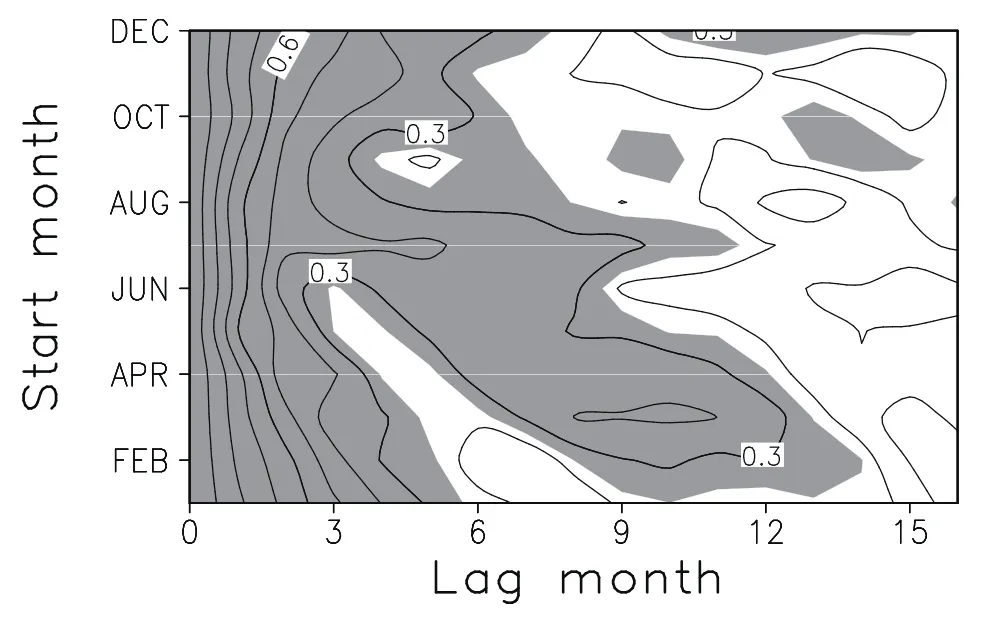
Fig.2.Lag correlation of the SSTAs in the LP region as a function of the start month(ordinate)and lag month(abscissa).The contour interval is 0.1 and shading indicates correlation coefficients that are statistically significant at the greater than 95%confidence level.
Figure 3 shows the correlation between the summer SSTAs in the LP region and the SSTAs in the North Pacific from the summer to the fall of the following year.Significant correlations in the SSTAs are primarily located in the midlatitude North Pacific.During the summer,the pattern has a maximum amplitude along 30°–40°N,especially in the western and central North Pacific(Fig.3a).This pattern appears to persist into the spring of the following year(Figs.3b–d).The sustained correlations weaken(Fig.3e)and then disappear(Fig.3f)during the summer and fall of the following year.
The correlation pattern of the SSTAs in Fig.3a is similar to the results based on the EOF analysis by Zhang et al.(1998).These authors also noted that the pattern could persist from the summer to the winter and exhibit stronger persistence than the SSTAs at fixed grid points.Conversely,Zhang et al.(1998)suggested that the SSTAs in the North Pacific persist not only from the summer to the winter but also from the winter to the summer.However,our results indicate that the winter SSTAs diminish in the summer and recur in the following winter in the LP region(Fig.2).Therefore,it is possible that the persistence at the surface(Zhang et al.,1998)and the reemergence mechanism(Alexander et al.,1999)may both operate in the LP region.
4.Seasonal cycle of the oceanic mixed layer
Frankignoul and Hasselmann(1977)established a simple stochastic climate model for midlatitude SST variability,

whereandhrepresent the oceanic temperature anomalies in the mixed layer,the atmospheric forcing,and the mean maximum MLD,respectively.And ρ is the density of seawater,cpis the heat capacity of seawater,and λ is a linear damping coefficient.The model is the same as that employed in Zhao et al.(2012).If the stochastic atmospheric forcing is represented by white noise,the SSTAs will decrease exponentially at a rate proportional to the inverse of the MLD,r(τ)=exp[?λτ/ρcph].This model suggests that the persistence time is longer if the mixed layer is deeper.
Figure 4 shows the climatological MLD in the North Pacific during the winter and summer.The MLD in the North Pacific is much shallower in the summer than in the winter.Based on the above simple stochastic model,a shallow MLD will result in short persistence times of SSTAs during the summer.Obviously,the long persistence times of the summer SSTAs in the LP region cannot be explained by this sim-ple stochastic model.The discrepancy of the model stems from the assumption that SSTAs are forced by random atmospheric variability and decay by damping back to the atmosphere.Therefore,we should consider the contribution of atmospheric physical processes to the long persistence of summer SSTAs in the LP region.
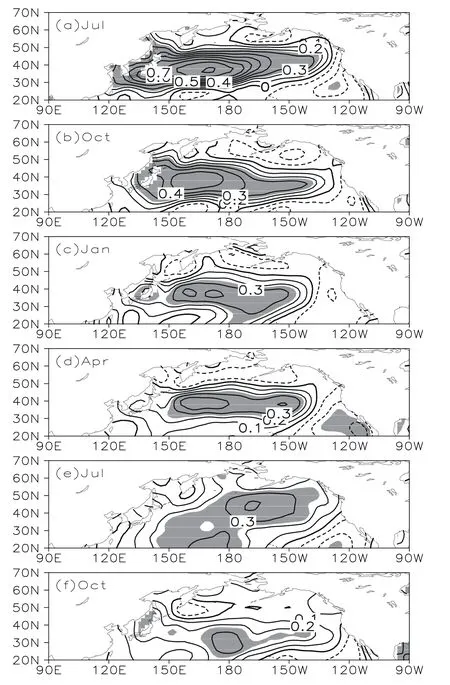
Fig.3.Lag correlation coefficients between summer(July)SSTAs in the LP region and the SSTAs in the North Pacific from July of the current year through October of the following year.The contour interval is 0.1,and shading indicates correlation coefficients that are statistically signi ficant at the 95%confidence level.
5.Atmospheric forcing
Figure 5a shows the correlation between the SSTAs in the LP region and the geopotential height anomalies(GPHAs)and the wind anomalies at 850 hPa in the North Pacific during the summer(July).The LP SSTAs have significantly positive correlations with the GPHAs over the western and central North Pacific.An anomalous anticyclone accompanies this positive correlation between the SSTAs and the GPHAs in the summertime(Fig.5a).When the GPHAs are positive(negative),there is an anomalous anticyclone(cyclone)with anomalous easterlies(westerlies),which induces warm(cool)SSTAs(e.g.,Nonaka and Xie,2003;Wu and Kinter,2010).Moreover,the positive correlation between the SSTAs and the GPHAs in the LP region are maintained throughout the year when the atmosphere leads the ocean by one month.This result indicates that the atmospheric forcing dominates the ocean in seasons other than the wintertime(e.g.,Deser and Timlin,1997).Figure 6 shows the contribution of the changes in geopotential height to the persistence of the summer SSTAs in the LP region.The lag correlation is weaker than that in Fig.3,and the positive correlation moves eastward after January.Thus,although the atmospheric circulation anomalies make some contribution to the long persistence of summer SSTAs in the LP region,this does not seem to fully explain the persistence.There are still other factors that sustain the summertime SSTAs in this region.
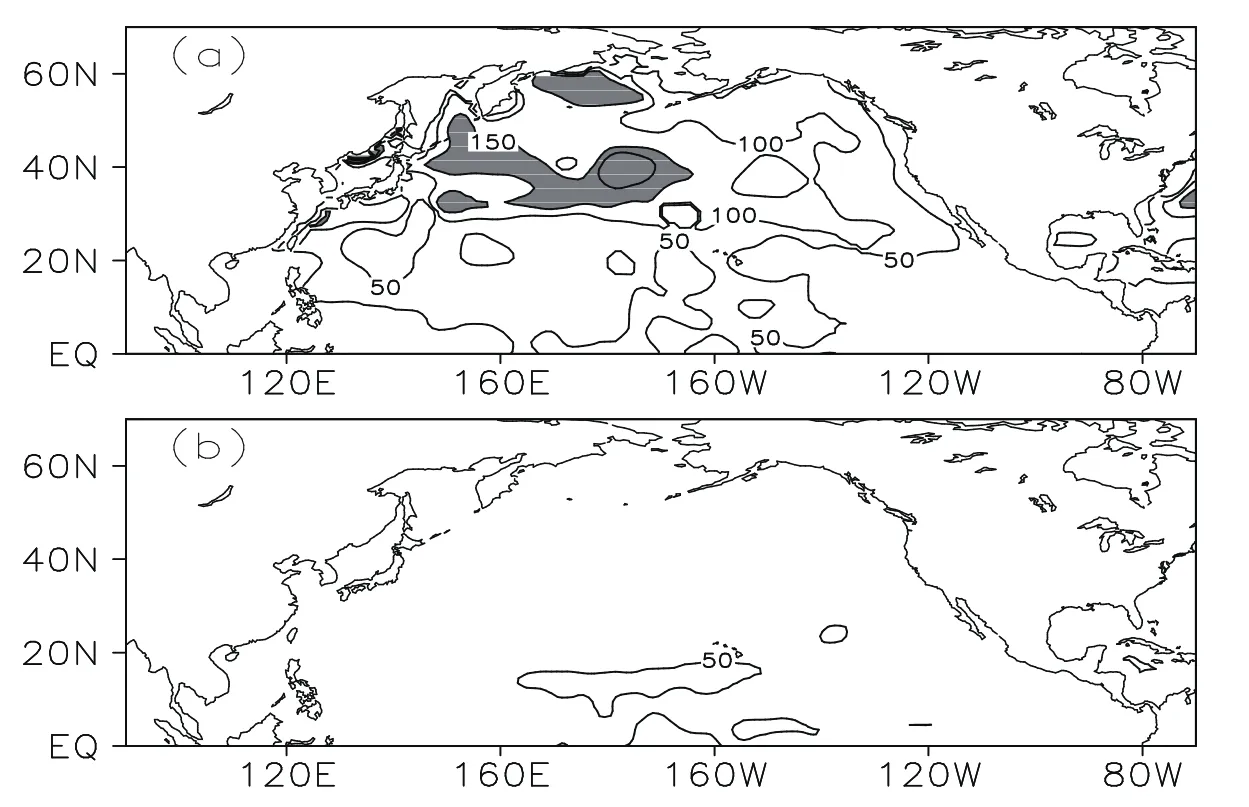
Fig.4.Climatological MLD in the North Pacific in(a)February and(b)July.Shading indicates a difference greater than 150 m.
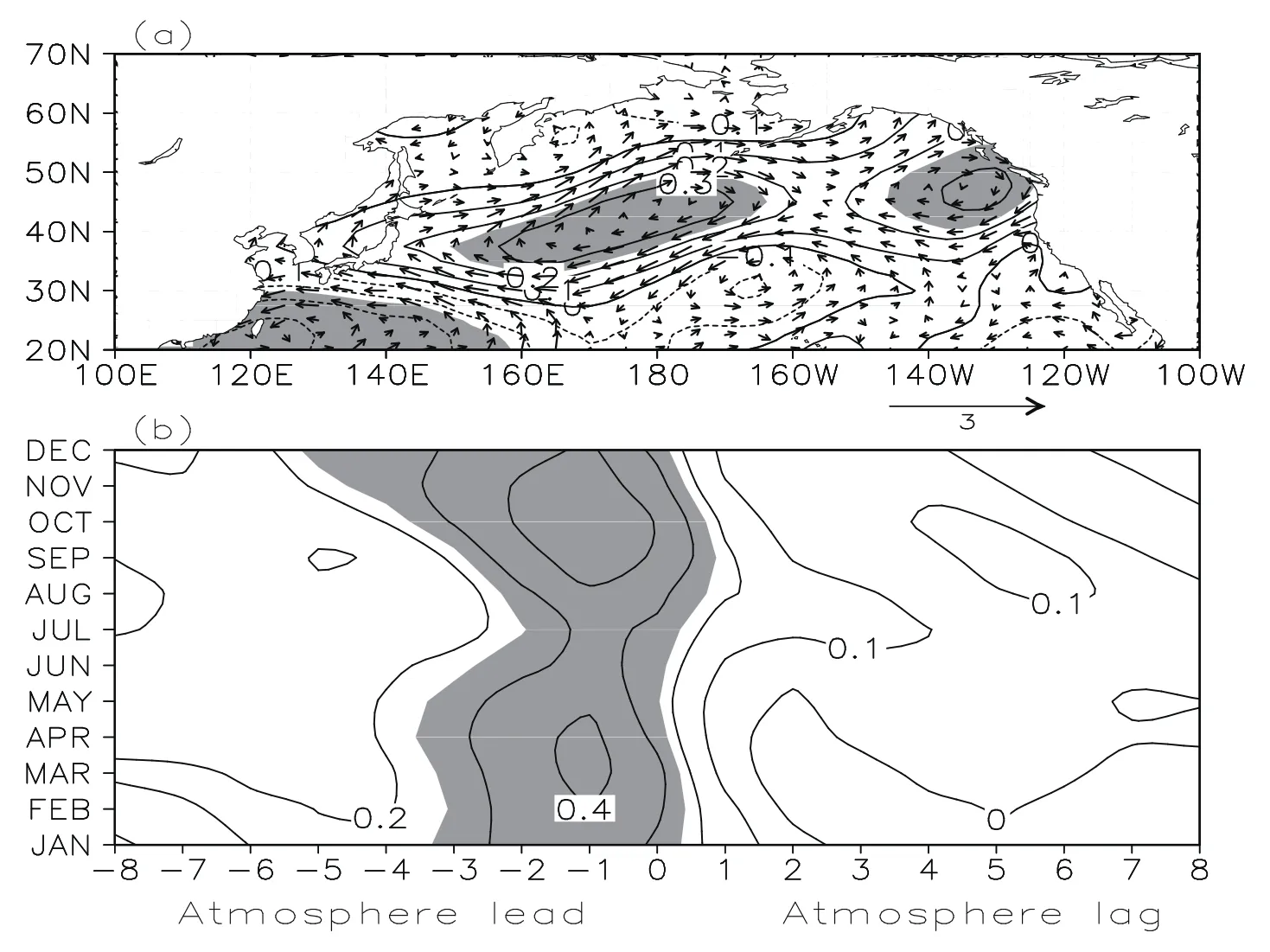
Fig.5.(a)Correlation coefficients between the SSTAs in the LP region and the GPHAs and the wind anomalies at 850 hPa in the North Pacific during the summer(July).The contour interval is 0.1,and shading indicates correlation coefficients that are statistically significant at the 95%confidence level.(b)Monthly lead–lag correlation between the SSTAs and the GPHAs at 850 hPa averaged over the LP region.The ordinate is the SSTA calendar month;the abscissa is the lag,where a negative lag refers to the GPHA leading the SSTA.Shading indicates statistical significance at the 95%confidence level.
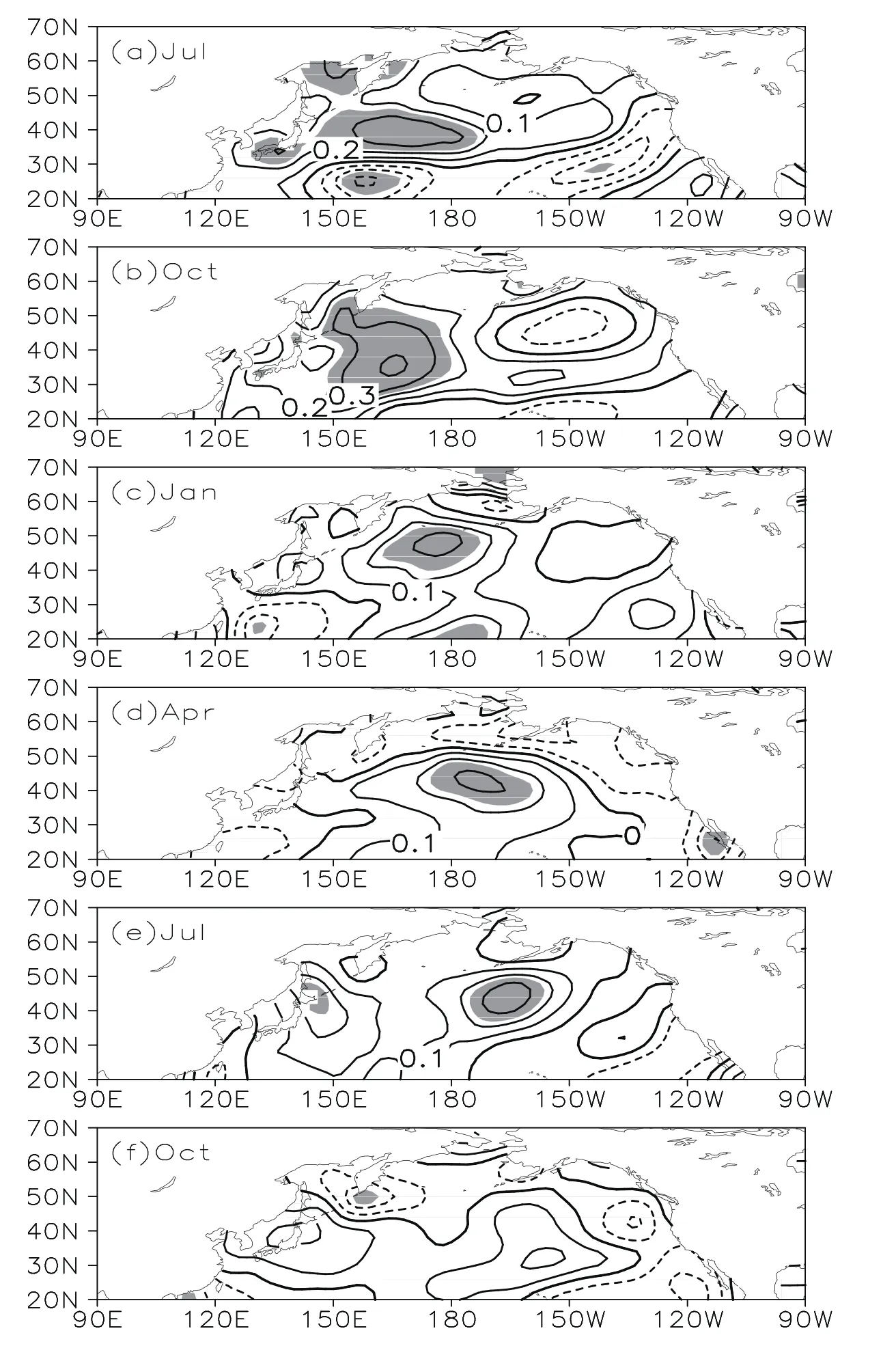
Fig.6.Lag correlation coefficients between summer GPHAs at 850 hPa in the LP region and the SSTAs in the North Pacific from July of the current year through October of the following year.The contour interval is 0.1,and shading indicates correlation coefficients that are statistically significant at the 95%confidence level.
Furthermore,the relative contribution of the changes in the heat flux(latent and sensible heat flux,and downward longwave and shortwave radiation flux)to the persistence of the summer SST As is investigated in theL Pregion.Asshown in Fig.7,longwave radiation flux anomalies(Fig.7c)are crucial to sustaining the summertime SST As because the patterns and magnitudes of the lag correlation are very similar to those in Fig.3.Although the latent heat flux anomalies contribute to the persistence of the summer SSTAs,the correlations are weak in the LP region.The net sensible heat flux and shortwave radiation flux anomalies are not significantly correlated with the SSTAs in the LP region throughout the seasons.
6.Interdecadal variability of the persistence of summer SSTAs
The interdecadal variability of the persistence of the summer SSTAs in the LP region is investigated using a moving lagged autocorrelation analysis.As shown in Fig.8,the persistence times of the summer SSTAs in the LP region are very short before 1982,but they are relatively longer after 1982,although there is a decrease during 1995–2000.Because the abrupt change mainly occurs in 1982/83,the following analysis compares the differences between the periods of 1950–82 and 1983–2016.

Fig.7.Lag correlation coefficients between the summer net latent and sensible heat flux anomalies,and the downward long wave and shortwave radiation flux anomalies in the LP region and the SSTAs in the North Pacific from July of the current year through October of the following year.The contour interval is 0.1,and shading indicates correlation coefficients that are statistically significant at the 95%con fidence level.
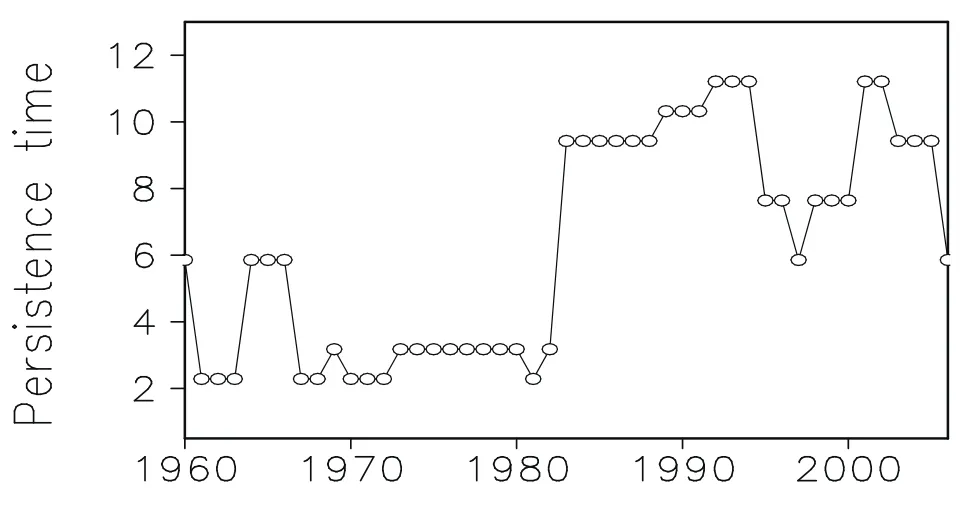
Fig.8.Persistence time(in months)of the summer SSTAs in LP region,in which the lagged autocorrelation coefficients are calculated with a 21-year moving window.
In the North Pacific,most regions display stronger persistence of summer SSTAs after 1982 than before,especially in the LP region(Fig.9).The correlation patterns of the summer SSTAs appear to persist into the spring of the following year after 1982,but the patterns persist for only one season before 1982(Fig.10).To further examine in detail the mechanism of the interdecadal variability of the persistence of summer SSTAs in the LP region,the relative contributions of atmospheric circulation,latent heat flux,and downward long wave radiation flux changes between 1950–82 and 1983–2016 are compared.
As shown in Fig.11,the atmospheric circulation anomalies exhibit significant differences between the two periods.The positive correlation between the SSTAs and the GPHAs exhibits similar patterns during 1982–2016 and the whole period(1950–2016),but the correlations are very weak and the center moves westward before 1982.Thus,the atmospheric forcing on the oceanic temperature in the summer significantlyenhances and sustains for a longer time after1982(Fig.12).Hence,the atmospheric circulation anomalies contribute to the interdecadal variability of the persistence of the summer SSTAs in the LP region.
As mentioned in section 5,longwave radiation flux and net latent heat flux also contribute to the persistence of the summer SSTAs.Similarly,the longwave radiation flux is also a major factor of the interdecadal variability.After 1982,the strong correlation between the longwave radiation flux and the SSTAs can be sustained to the spring of the following year(Fig.13).However,before 1982,the correlation becomes weak after October.Compared with those of the long wave radiation flux,the contributions of the net latent heat flux to the interdecadal variability of the persistence of the summertime SSTAs in the LP region are small(Fig.14).
7.Conclusion
In the present study,the characteristics of the persistence of summer SSTAs in the North Pacific and its interdecadal variability are investigated.The persistence of the summer SSTAs shows obvious geographical differences in the North Pacific.The summer SSTAs have long persistence times of approximately 8–14 months over the KE region.The associated SSTAs pattern is primarily located in the midlatitude North Pacific,and the pattern persists to the spring and summer of the following year.
There is no exclusive source of “memory”under the ocean surface during the summer,so it seems that some types of positive feedback operating at the air–sea interface prolong the persistence of summertime SSTAs in the LP region.Although the seasonal evolution of the atmosphere is great in the winter and small in the summer in this region,even a small air–sea surface anomaly in the summer can induce large SST changes because of the much shallower MLD in the summer.
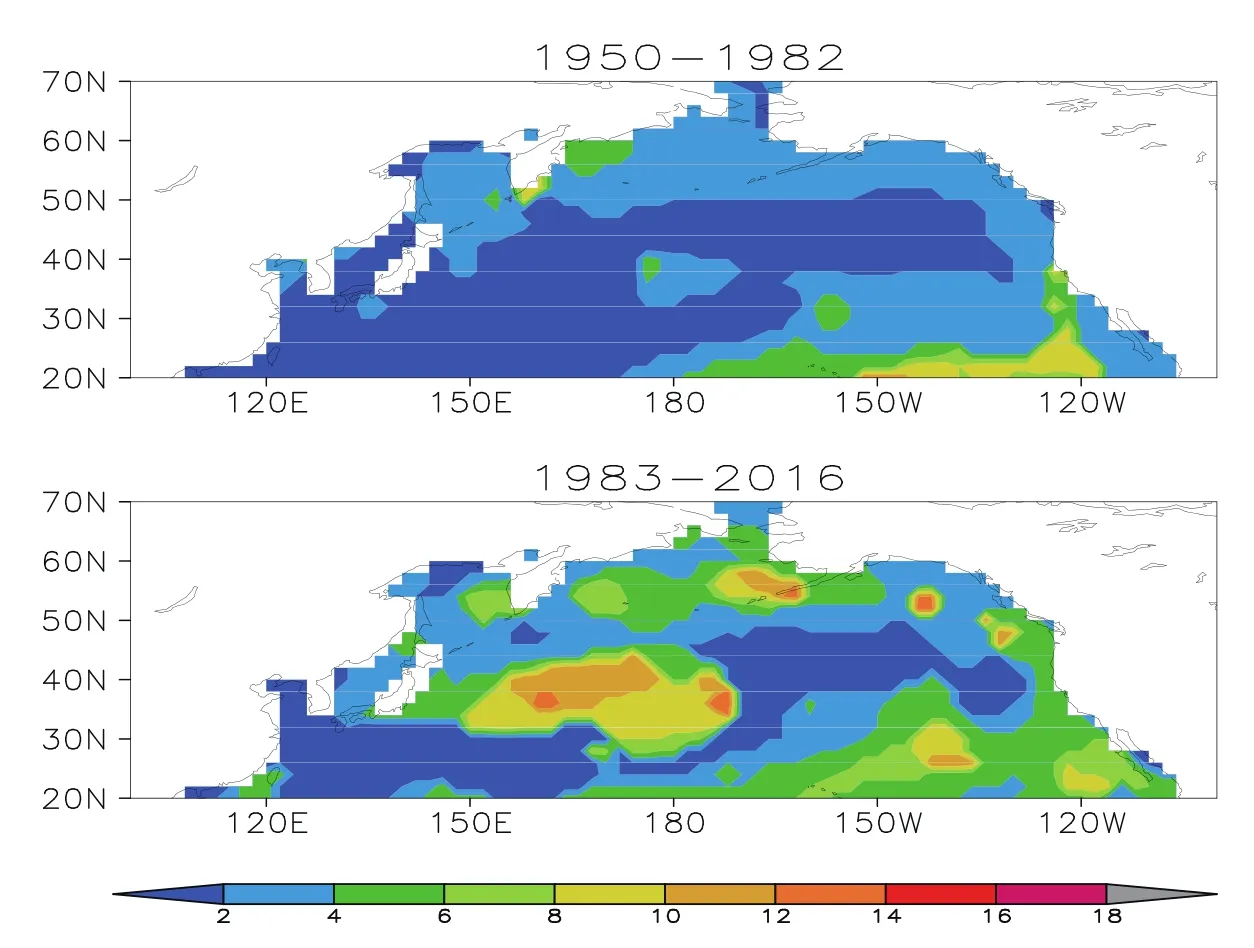
Fig.9.As in Fig.1 but for the periods of 1950–82 and 1983–2016.
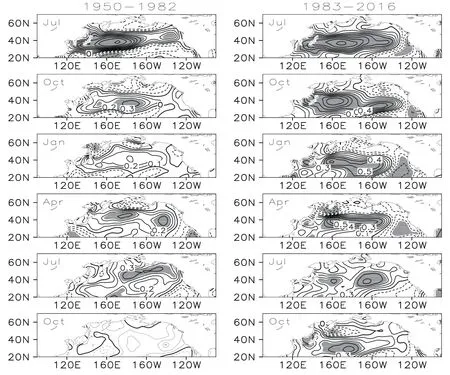
Fig.10.As in Fig.3 but for the periods of 1950–82 and 1983–2016.

Fig.11.As in Fig.5a but for the periods of 1950–82 and 1983–2016.
Our analyses indicate that the correlations between the atmospheric circulation anomalies and SSTAs are significantly positive in the LP region.Moreover,the lead–lag correlation shows that the positive value is greatest when the atmosphere leads the ocean by one month,suggesting that the role of atmospheric forcing is dominant in the ocean not only during the wintertime.Therefore,atmospheric circulation anomalies are very important to the persistence of the summer SSTAs in the LP region.However,the atmospheric circulation anomalies do not seem to fully explain the persistence of the SSTAs.There are still other factors that sustain the summertime SSTAs in this region.The long wave radiation flux anomalies are crucial to sustaining the summertime SSTAs.Although latent heat flux anomalies contribute to the persistence of the summer SSTAs,the correlations are weak in the LP region.The net sensible heat flux and shortwave radiation flux anomalies are not significantly correlated with the SSTAs in the LP region throughout the seasons.This result is different from that of Norris et al.(1998),who emphasized the importance of positive cloud feedback to SST.
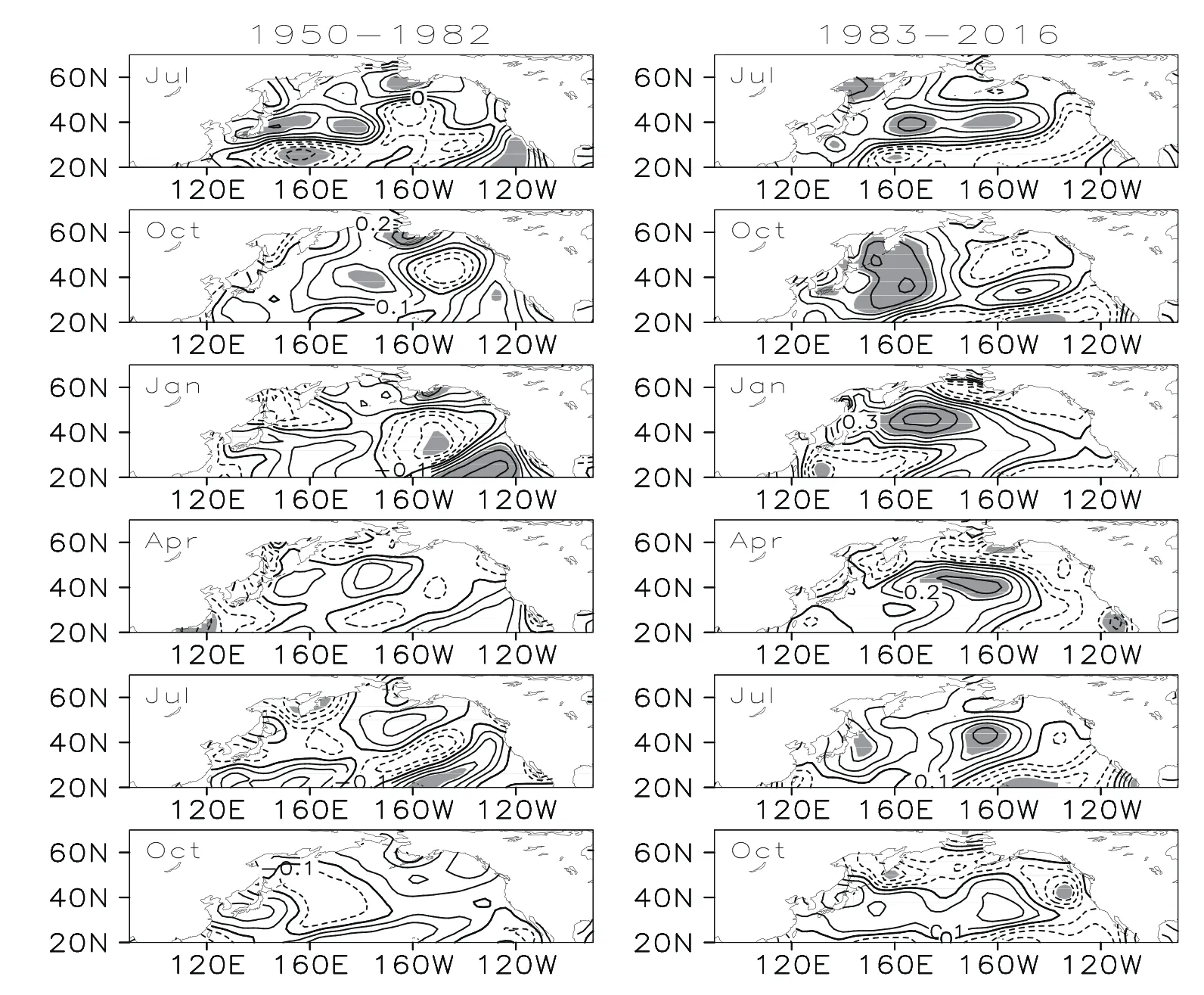
Fig.12.Lag correlation coefficients between summer GPHAs at 850 hPa in the LP region and the SSTAs in the North Pacific from July of the current year through October of the following year for the periods of 1950–82 and 1983–2016.The contour interval is 0.1,and shading indicates correlation coefficients that are statistically significant at the 95%confidence level.
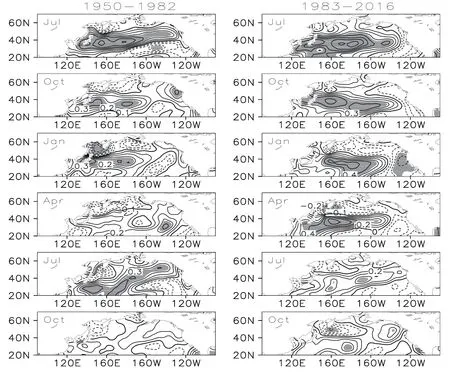
Fig.13.As in Fig.12 but for the downward long wave radiation flux anomalies.
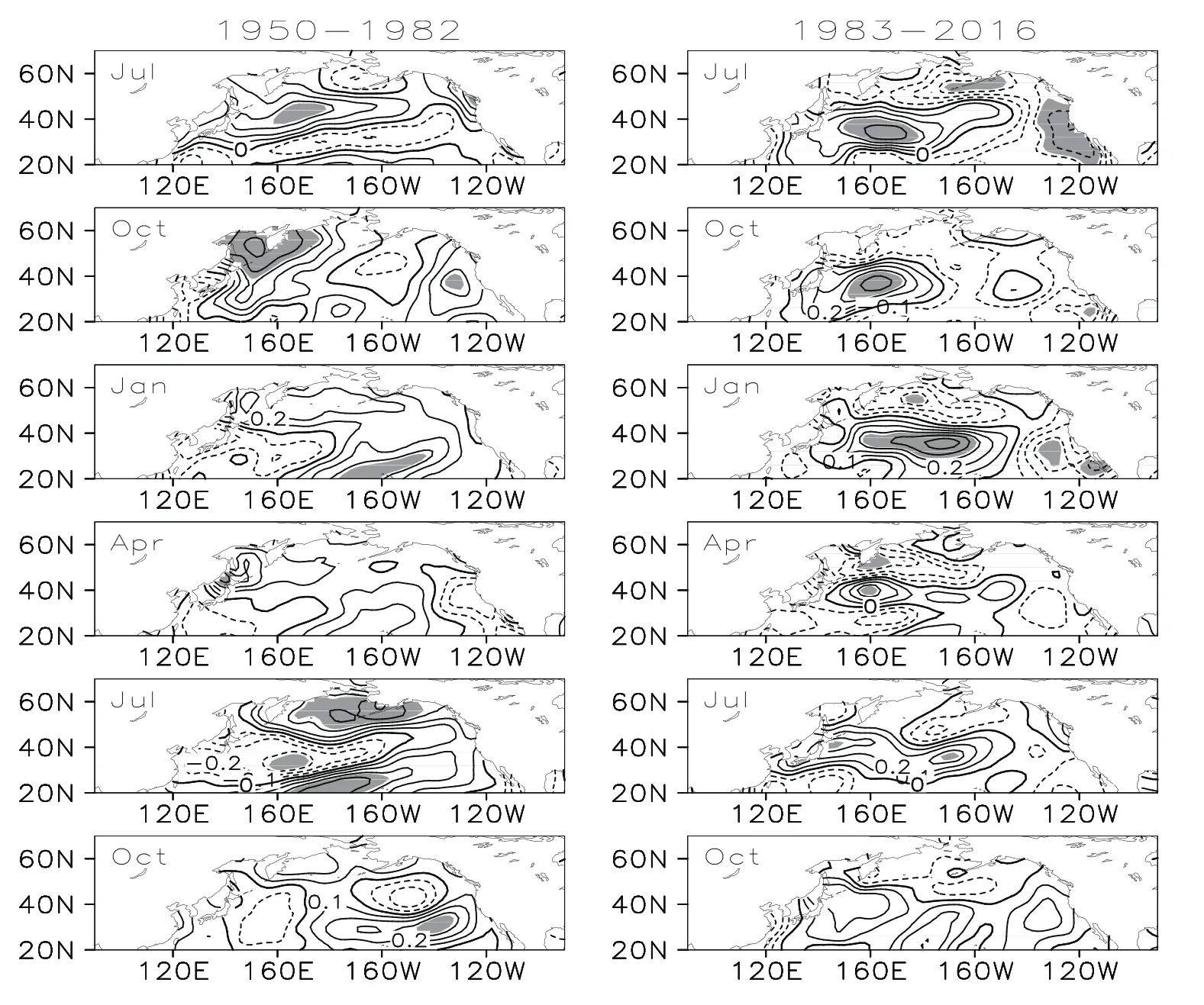
Fig.14.As in Fig.12 but for the net latent heat flux anomalies.
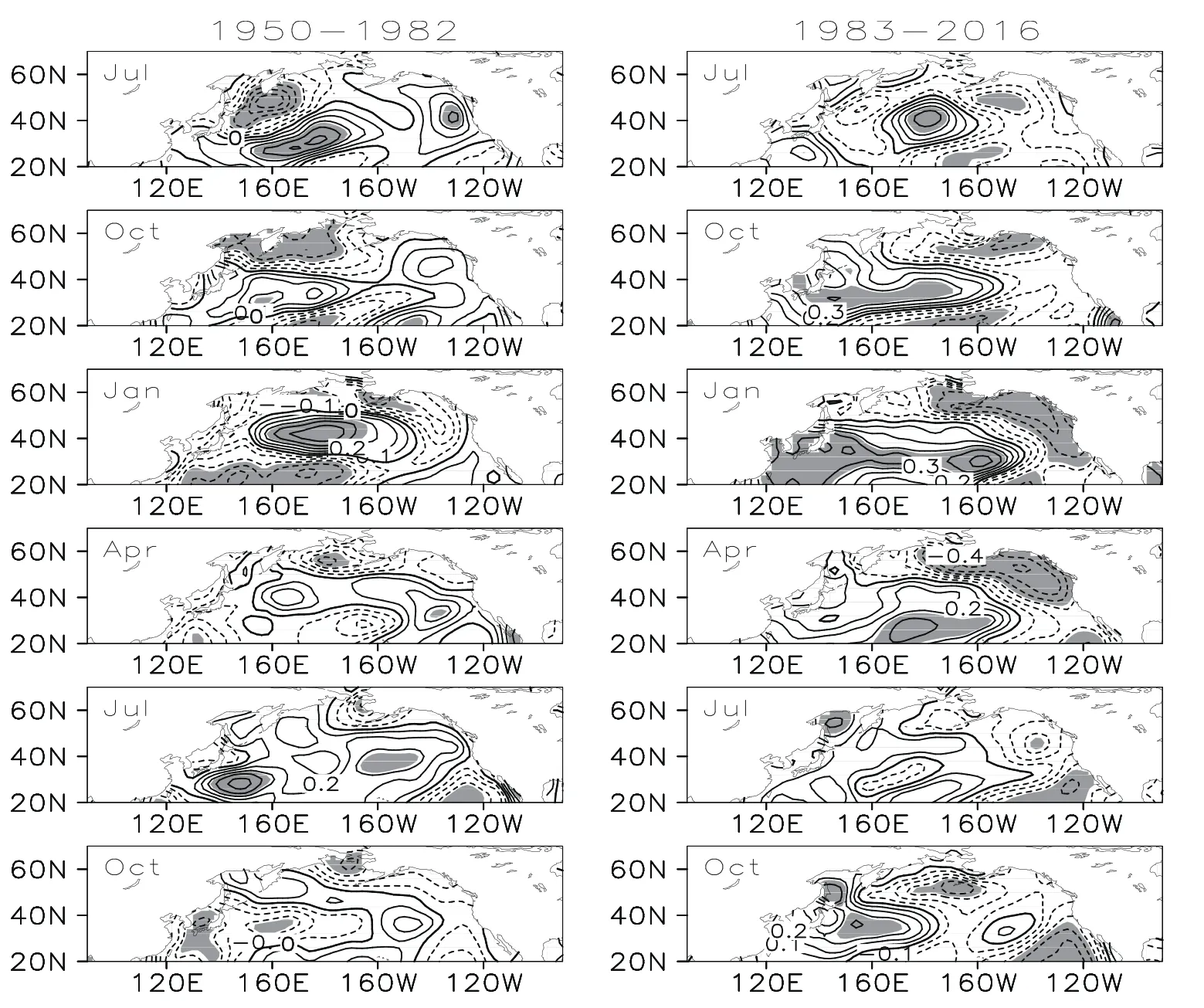
Fig.15.As in Fig.12,but for the zonal oceanic current anomalies.
The interdecadal variability is reflected in the persistence of the summer SSTAs in the North Pacific.Especially around the KE region,the persistence of the summer SSTAs is much longer after 1982 than before.Consistent with the longer persistence of SSTAs in the LP region,the for cings of atmospheric circulation,latent heat flux,and downward longwave radiation flux anomalies on the SSTAs are stronger and are sustained for longer after 1982.
Surface wind stress and oceanic currents are linked;thus,the contributions of the changes in the zonal and meridional oceanic currents to the persistence of the summer SSTAs are also investigated using ECMWF ORAS4 ocean reanalysis data,which covers 1958 to 2015.As shown in Fig.15,the summer meridional current anomalies are not significantly correlated with the SSTAs in the LP region in the following seasons.Although the zonal current anomalies contribute to some of the persistence of the summer SSTAs in the LP region,the correlation weakens after the winter.Other dynamic oceanic processes,such as subduction,advection,mixing and diffusion(Qiu,2000;Xie et al.,2000;Tomita et al.,2002;Sugimoto and Hanawa,2005;Wu and Kinter,2010),may in fluence the persistence of SSTAs,so further analyses are needed.
Acknowledgements.This work was supported by the National Natural Science Foundation of China(NSFC)(GrantNos.41375094 and 41406028),the Basic Scienti fic Research Fund for National Public Institutes of China(Grant No.GY0215P04),the Strategic Priority Research Program of the Chinese Academy of Sciences(Grant No.XDA11010102),the NSFC–Shandong Joint Fund for Marine Science Research Centers(Grant No.U1406401),and the Foundation for Innovative Research Groups of the NSFC(Grant No.41421005).
REFERENCES
Achuthavarier,D.,S.D.Schubert,and Y.V.Vikhliaev,2017:North Pacific decadal variability:Insights from a biennial ENSO environment.Climate Dyn.,49,1379–1397,https://doi.org/10.1007/s00382-016-3391-1.
Alexander,M.A.,and C.Deser,1995:A mechanism for the recurrence of wintertime midlatitude SST anomalies.J.Phys.Oceanogr.,25,122–137,http://dx.doi.org/10.1175/1520-0485(1995)025<0122:AMFTRO>2.0.CO;2.
Alexander,M.A.,C.Deser,and M.S.Timlin,1999:The reemergence of SST anomalies in the North Pacific Ocean.J.Climate,12,2419–2433.
Alexander,M.A.,I.Blad′e,M.Newman,J.R.Lanzante,N.-C.Lau,and J.D.Scott,2002:The atmospheric bridge:The influence of ENSO teleconnections on air–sea interaction over the global oceans.J.Climate,15,2205–2231,http://dx.doi.org/10.1175/1520-0442(2002)015<2205:TABTIO>2.0.CO;2.
Chen,D.,H.J.Wang,Y.Song,and Y.Gao,2016:A multidecadal oscillation in the northeastern Pacific.Atmospheric and Oceanic Science Letters,9(4),315–326,http://dx.doi.org/10.1080/16742834.2016.1194716.
Davis,R.E.,1978:Predictability of sea level pressure anomalies over the North Pacific Ocean.J.Phys.Oceanogr.,8,233–246,http://dx.doi.org/10.1175/1520-0485(1978)008<0233:POSLPA>2.0.CO;2.
Ding,R.Q.,and J.P.Li,2009:Decadal and seasonal dependence of North Pacific sea surface temperature persistence.J.Geophys.Res.,114,D01105,http://dx.doi.org/10.1029/2008 JD010723.
Deser,C.,and M.S.Timlin,1997:Atmosphere–ocean interaction on weekly timescales in the North Atlantic and Pacific.J.Climate,10,393–408.
Deser,C.,M.A.Alexander,and M.S.Timlin,2003:Understanding the persistence of sea surface temperature anomalies in midlatitudes.J.Climate,16,57–72,http://dx.doi.org/10.1175/1520-0442(2003)016<0057:UTPOSS>2.0.CO;2.
Frankignoul,C.,and K.Hasselmann,1977:Stochastic climate models,Part II Application to sea-surface temperature anomalies and thermocline variability.Tellus,29,289–305,http://dx.doi.org/10.1111/j.2153-3490.1977.tb00740.x.
Frankignoul,C.,and N.Senn′echael,2007:Observed in fluence of North Pacific SST anomalies on the atmospheric circulation.J.Climate,20,592–606,https://doi.org/10.1175/JCLI4021.1.
Hanawa,K.,and S.Sugimoto,2004:‘Reemergence’areas of winter sea surface temperature anomalies in the world’s oceans.Geophys.Res.Lett.,31,L10303,https://doi.org/10.1029/2004GL019904.
Huang,B.Y.,and Coauthors,2017:Extended reconstructed sea surface temperature,version 5(ERSSTv5):Upgrades,validations,and intercomparisons.J.Climate,30,8179–8205,https://doi.org/10.1175/JCLI-D-16–0836.1.
Kalnay,E.,and Coauthors,1996:The NCEP/NCAR 40-year reanalysis project.Bull.Amer.Meteor.Soc.,77,437–471,http://dx.doi.org/10.1175/1520-0477(1996)077<0437:TNYRP>2.0.CO;2.
Lau,K.-M.,K.-M.Kim,and S.S.P.Chen,2002:Potential predictability of seasonal precipitation over the United States from canonical ensemble correlation predictions.Geophys.Res.Lett.,29,1-1–1-4,https://doi.org/10.1029/2001 GL014263.
Liu,Z.Y.,and L.X.Wu,2004:Atmospheric response to North Pacific SST:The role of ocean–atmosphere coupling.J.Climate,17,1859–1882,http://dx.doi.org/10.1175/1520-0442(2004)017<1859:ARTNPS>2.0.CO;2.
Mantua,N.J.,and S.R.Hare,2002:The Pacific decadal oscillation.J.Oceanogr.,58,35–44,http://dx.doi.org/10.1023/A:1015820616384.
Mantua,N.J.,S.R.Hare,Y.Zhang,J.M.Wallace,and R.C.Francis,1997:A Pacific interdecadal climate oscillation with impacts on salmon production.Bull.Amer.Meteor.Soc.,78,1069–1079,http://dx.doi.org/10.1175/1520-0477(1997)078<1069:APICOW>2.0.CO;2.
Miller,A.J.,and N.Schneider,2000:Interdecadal climate regime dynamics in the North Pacific Ocean:Theories,observations and ecosystem impacts.Progress in Oceanography,47,355–379,https://doi.org/10.1016/S0079-6611(00)00044-6.
Monterey,G.I.,and S.Levitus,1997:Seasonal Variability of Mixed Layer Depth for the World Ocean.NOAA NESDIS,92 pp.
Namias,J.,and R.M.Born,1970:Temporal coherence in North Pacific sea-surface temperature patterns.J.Geophys.Res.,75,5952–5955,http://dx.doi.org/10.1029/JC075i030p05952.
Namias,J.,and R.M.Born,1974:Further studies of temporal coherence in North Pacific sea surface temperatures.J.Geophys.Res.,79,797–798,http://dx.doi.org/10.1029/JC079i006p00797.
Newman,M.,and Coauthors,2016:The Pacific decadal oscillation,revisited.J.Climate,29,4399–4427,https://doi.org/10.1175/JCLI-D-15-0508.1.
Nonaka,M.,and S.-P.Xie,2003:Covariations of sea surface temperature and wind over the Kuroshio and its extension:Evidence for ocean-to-atmosphere feedback.J.Climate,16,1404–1413,http://dx.doi.org/10.1175/1520-0442(2003)16<1404:COSSTA>2.0.CO;2.
Norris,J.R.,Y.Zhang,and J.M.Wallace,1998:Role of clouds in summertime atmosphere-ocean interactions over the North Pacific.J.Climate,11,2482–2490.
Qiu,B.,2000:Interannual variability of the Kuroshio Extension system and its impact on the wintertime SST field.J.Phys.Oceanogr.,30,1486–1502,http://dx.doi.org/10.1175/1520-0485(2000)030<1486:IVOTKE>2.0.CO;2.
Sugimoto,S.,and K.Hanawa,2005:Remote reemergence areas of winter sea surface temperature anomalies in the North Pacific.Geophys.Res.Lett.,32,L01606,https://doi.org/10.1029/2004GL021410.
Tomita,T.,S.-P.Xie,and M.Nonaka,2002:Estimates of surface and subsurface forcing for decadal sea surface temperature variability in the mid-latitude North Pacific.J.Meteor.Soc.Japan,80,1289–1300.
Trenberth,K.E.,and J.W.Hurrell,1994:Decadal atmospheric–ocean variations in the Pacific.Climate Dyn.,9,303–319,http://dx.doi.org/10.1007/BF00204745.
Wallace,J.M.,Y.Zhang,and K.-H.Lau,1993:Structure and seasonality of interannual and interdecadal variability of the geopotential height and temperature fields intheNorthernHemispheretroposphere.J.Climate,6,2063–2082,https://doi.org/10.1175/1520-0442(1993)006<2063:SASOIA>2.0.CO;2.
Wu,R.G.,and J.L.Kinter III,2010:Atmosphere-ocean relationship in the midlatitude North Pacific:Seasonal dependence and east-west contrast.J.Geophys.Res.,115,D06101,http://dx.doi.org/10.1029/2009JD012579.
Xiao,D.,and J.P.Li,2007:Spatial and temporal characteristicsof the decadal abrupt changes of global atmosphere-ocean system in the 1970s.J.Geophys.Res.,112,D24S22,https://doi.org/10.1029/2007JD008956.
Xie,S.P.,T.Kunitani,A.Kubokawa,M.Nonaka,and S.Hosoda,2000:Interdecadal thermocline variability in the North Pacific for 1958–97:A GCM simulation.J.Phys.Oceanogr.,30,2798–2813,http://dx.doi.org/10.1175/1520-0485(2000)030<2798:ITVITN>2.0.CO;2.
Zhang,Y.,J.M.Wallace,and D.S.Battisti,1997:ENSO-like interdecadal variability:1900–93.J.Climate,10,1004–1020,http://dx.doi.org/10.1175/1520-0442(1997)010<1004:ELIV>2.0.CO;2.
Zhang,R.-H.,L.M.Rothstein,and A.J.Busalacchi,1998:Origin of upper-ocean warming and El Ni?no change on decadal scales in the tropical Pacific Ocean.Nature,391,879–883,http://dx.doi.org/10.1038/36081.
Zhao,X.,and J.P.Li,2010:Winter-to-winter recurrence of sea surface temperature anomalies in the Northern Hemisphere.J.Climate,23,3835–3854,https://doi.org/10.1175/2009 JCLI2583.1.
Zhao,X.,andJ.P.Li,2012a:Winter-to-winterrecurrence and non winter-to-winter recurrence of SST anomalies in the central North Pacific.J.Geophys.Res.,117,C05027,https://doi.org/10.1029/2011JC007845.
Zhao,X.,and J.P.Li,2012b:Winter-to-winter recurrence of atmospheric circulation anomalies in the central North Pacific.J.Geophys.Res.,117,C12023,http://dx.doi.org/10.1029/2012 JC008248.
Zhao,X,J.P.Li,and W.J.Zhang,2012:Summer persistence barrier of sea surface temperature anomalies in the central western north Pacific.Adv.Atmos.Sci.,29,1159–1173,https://doi.org/10.1007/s00376-012-1253-2.
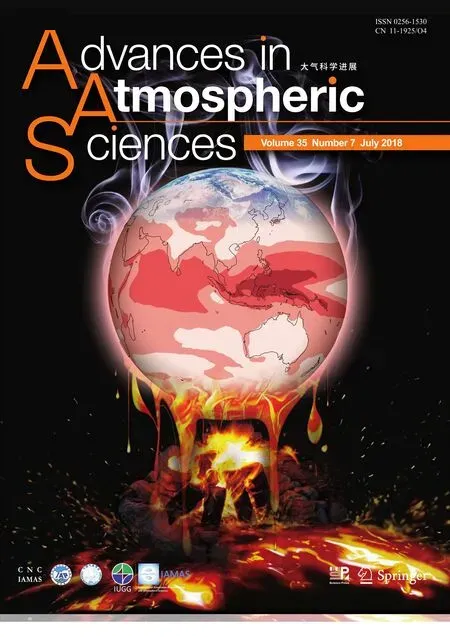 Advances in Atmospheric Sciences2018年7期
Advances in Atmospheric Sciences2018年7期
- Advances in Atmospheric Sciences的其它文章
- Dominant SST Mode in the Southern Hemisphere Extratropics and Its Influence on Atmospheric Circulation
- ENSO Predictions in an Intermediate Coupled Model In fluenced by Removing Initial Condition Errors in Sensitive Areas:A Target Observation Perspective
- Impact of Soil Moisture Uncertainty on Summertime Short-range Ensemble Forecasts
- Regional Characteristics of Typhoon-Induced Ocean Eddies in the East China Sea
- Comparisons of Three-Dimensional Variational Data Assimilation and Model Output Statistics in Improving Atmospheric Chemistry Forecasts
- An Asymmetric Spatiotemporal Connection between the Euro-Atlantic Blocking within the NAO Life Cycle and European Climates
